Ensure your dog’s safety around the pool by implementing marked exits, vigilant supervision, proper identification, shielding from chemicals, and effective training. Remember, keeping your furry friend safe in the water requires a comprehensive approach.
Key Takeaways
- Mark pool exits for safety; prevent drowning.
- Supervise all dogs during swimming activities.
- Ensure updated identification tags and microchips.
- Use pet-friendly products to protect from chemicals.
- Train dogs for pool safety with positive reinforcement.
Marking Pool Exits for Safety
Marking pool exits is a vital step in ensuring the safety of dogs when they are in the water. Not all dogs are proficient swimmers, and some may forget to use their front and back legs effectively.
To protect them from potential drowning incidents, it is important to make pool exits easily identifiable. Using markers to guide dogs towards pool steps can help them navigate the pool area safely.
Training all dogs to use these designated exits by reinforcing proper use with praise and treats is paramount. By ensuring that dogs can easily find and use pool steps, pet owners can greatly reduce the risks associated with canine swimming activities, promoting a safer and more enjoyable experience for their furry companions.
Supervision for Swim Safety
Supervising dogs during swimming activities is vital to guarantee their safety and prevent potential accidents in the pool. Regardless of their swimming proficiency, all dogs, whether beginners or expert swimmers, require vigilant supervision.
Risks such as ingesting pool water, exposure to chlorine and chemicals, and accidents can be minimized with proper oversight. It is essential to monitor dogs closely to make sure they do not tire easily, struggle in the water, or face any difficulties while swimming.
Providing easy access to fresh water for hydration and being mindful of their well-being are key responsibilities for dog owners supervising pool activities. By staying attentive and proactive, pet owners can create a safe and enjoyable swimming experience for their canine companions.
Identification Tags and Microchips

To enhance the safety and security of dogs in outdoor pool areas, it is imperative for pet owners to prioritize the use of identification tags and microchips.
Identification tags should include up-to-date contact information, making it easier for individuals to assist in reuniting lost dogs with their owners.
Microchips provide a more permanent form of identification, offering a reliable way to identify a dog even if their collar or tag is lost.
In the event that a dog escapes or gets lost near the pool, these measures notably increase the chances of a quick reunion.
Protecting Dogs From Chemicals
When maintaining a safe pool environment for dogs, it is crucial to protect them from harmful chemicals commonly found in pool areas. Sunscreens, insect repellents, and pool chemicals can pose risks to our furry friends. To ensure their safety, here are some key points to keep in mind:
| Chemical Type | Potential Harm | Preventive Measures |
|---|---|---|
| Sunscreens | Skin irritation | Use pet-friendly products |
| Insect Repellents | Toxicity if ingested | Keep out of reach |
| Pool Chemicals | Respiratory issues | Rinse off after swimming |
Training Dogs for Pool Safety

Ensuring dogs are properly trained for pool safety is vital to prevent accidents and promote a safe swimming experience for our canine companions. Additionally, it is important to supervise dogs near the pool at all times, especially if they are not strong swimmers. Owners should also consider providing pool slide options for their dogs to safely enter and exit the pool. These measures can help prevent any potential accidents and ensure that our furry friends can enjoy the water without any risks to their safety.
Training dogs to be comfortable in and around the pool can greatly reduce the risk of drowning incidents.
Teaching dogs how to use pool exits, such as steps or ramps, is essential for their safety.
Using markers to guide dogs towards pool exits and rewarding them for successful navigation can reinforce this behavior.
Consistent training and positive reinforcement can help dogs understand pool safety measures and become confident swimmers.
Supervision during pool activities is also key to ensuring dogs remain safe and enjoy their time in the water.
Frequently Asked Questions
Are There Any Specific Breeds That Are More Prone to Pool Accidents?
Some dog breeds, like Bulldogs and Basset Hounds, are more prone to pool accidents due to their anatomy and swimming ability. It's essential for all dog owners to be aware of their pet's limitations and take necessary safety precautions.
Can I Use a Life Jacket for My Dog in the Pool?
While one may question the need for a life jacket for dogs in a pool, safety should always be the top priority. Utilizing a dog life jacket can provide an added layer of protection, especially for novice swimmers.
Is It Safe for My Dog to Swim in a Saltwater Pool?
Swimming in a saltwater pool can be safe for dogs, as long as precautions are taken. Monitor your dog closely, make sure they can easily exit the pool, and rinse them off after to prevent skin irritation.
How Can I Teach My Older Dog to Swim for the First Time?
Begin on a journey of trust and guidance with your senior companion. Patiently introduce water, consider a life jacket, and encourage gradual exposure. Celebrate each small victory, building confidence and joy in aquatic exploration.
What Should I Do if My Dog Ingests Pool Water Accidentally?
If your dog ingests pool water accidentally, monitor for symptoms like vomiting or diarrhea. Contact a veterinarian immediately if you notice any signs of distress. Prevent future incidents by supervising your pet closely during pool time.
Conclusion
To wrap up, ensuring the safety of our canine companions around pools is essential. By implementing strategies such as marking pool exits, providing supervision, utilizing identification tags and microchips, protecting dogs from chemicals, and training them for pool safety, pet owners can create a secure environment for their dogs to enjoy aquatic activities.
Remember, a little caution goes a long way in safeguarding our furry friends. So, let's delve into pool safety measures to keep our dogs safe and sound.










